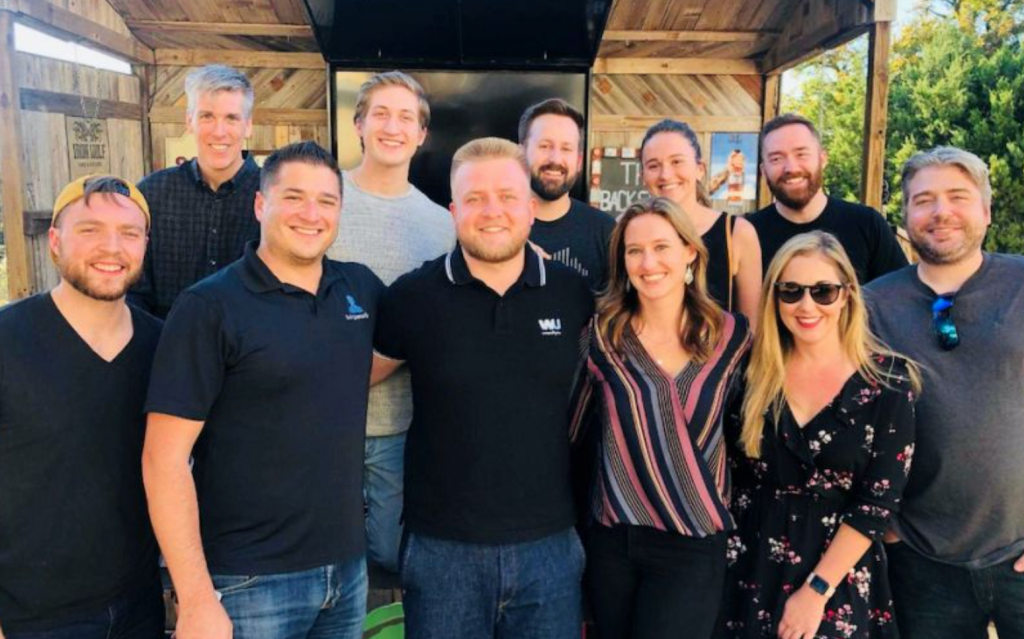The way we learn has changed forever. With the global e-learning industry growing by 900% between 2000 and 2020, digital platforms have evolved from a “nice-to-have” into a must-have, both for educational institutions and forward-thinking businesses. Whether it’s virtual classrooms for K–12 students, internal training portals, or full-fledged online universities, the demand for accessible, flexible learning experiences has never been higher.
And this demand shows no signs of slowing down. In fact, 93% of businesses worldwide plan to adopt e-learning in 2025, seeing it as a critical driver of knowledge retention, scalability, and cost efficiency. But building a truly effective e-learning platform is more than just uploading content to a website. It means creating intuitive UX for diverse users, ensuring data privacy and accessibility, and delivering real educational value through smart technology choices.
At WeSoftYou, we’ve helped organizations of all sizes—from EdTech startups to nonprofits—launch scalable, secure, and user-centric e-learning portals. In this article, we’ll walk you through the full development lifecycle: from defining the right features and architecture to choosing tech stacks, handling compliance, and designing for engagement. If you wonder how to create an online learning platform, this guide is your starting point.
Core Requirements to Ensure Before You Create an eLearning Platform
Before writing code or selecting tools, it’s critical to align your e-learning portal with the needs of real users: learners, educators, and administrators alike. This means going beyond basic functionality to define how the platform will support adaptive learning paths, real-time feedback loops, cross-device accessibility, and secure data handling from day one. A well-scoped foundation ensures your portal will work, scale, engage, and comply.
Identifying Your Target Audience and Use Cases
Before you start to build an online learning platform, take a step back and ask: who are we building this for? Whether you’re targeting corporate teams, K–12 students, university learners, or professionals seeking certification, each group brings its learning habits, digital proficiency, and access to technology. A one-size-fits-all approach won’t work.
Consider Digital Readiness and Accessibility
Beyond the “who,” dig into the “how.” Analyze your learners’:
- Digital proficiency — are they tech-savvy or need guidance?
- Device access — will they use smartphones, laptops, or school-issued tablets?
- Connectivity — is stable internet a given or a challenge?
This matters. For example, 43% of U.S. college students say digital tools are extremely helpful for coursework, so usability is essential.
Match Your Product to Real-World Use
K–12 students may need gamification and classroom alignment. Corporate learners likely want mobile access and real-time progress tracking. Academic portals often need LMS-grade tools like grading, assignments, and asynchronous learning flows.
Don’t guess—ask. Run quick surveys, interviews, or even focus groups. The earlier you map real needs and constraints, the better positioned you’ll be to build a portal people actually want to use.
Key Features Every e-Learning Portal Should Have
Drawing from industry benchmarks and our experience at WeSoftYou, a well-rounded e-learning portal is built on a foundation of essential features that support both learning outcomes and operational efficiency:
| Feature | Description | Why It Matters |
| Course Management | Create, organize, and update content using text, video, audio, and interactive media. | Enables scalable content delivery and simplifies content maintenance for instructors. |
| User Management | Define roles (learner, instructor, admin) with access control and permissions. | Enhances security and streamlines platform navigation for different user types. |
| Interactive Learning Tools | Quizzes, assignments, forums, peer reviews, and live sessions. | Boosts engagement and knowledge retention through active learning. |
| Progress Tracking and Analytics | Dashboards and reports that track user activity, completion, and performance metrics. | Provides insights to improve content, personalize learning, and demonstrate ROI. |
| Certification and Compliance | Automated certificates upon completion, compliance logs for regulated environments. | Builds credibility and supports training programs with legal or industry certification requirements. |
| Mobile Accessibility | Responsive web design or native mobile apps for learning across devices. | Ensures accessibility for users with limited desktop access or those who prefer mobile learning. |
Enhance the Core with Smart Personalization and Community Features
While foundational features are essential, standout e-learning platforms go beyond the basics:
- Social learning capabilities—such as peer feedback, collaborative projects, or discussion channels—can turn passive learners into active participants, fostering a deeper sense of connection and motivation.
- AI-driven personalization allows platforms to adapt to each learner’s pace, preferences, and progress. Smart recommendations, dynamic assessments, and adaptive content paths can significantly improve user engagement and learning outcomes.
Our team doesn’t stop at implementation. We build e-learning platforms that align with your strategic vision, whether you’re targeting employee growth, student success, or customer education, always customized to your audience, goals, and industry landscape.
Choosing the Right Technology Stack
The technology stack is a strategic decision that defines how your platform performs, scales, integrates, and evolves. For e-learning portals, that means balancing performance with flexibility, security with usability, and innovation with long-term maintainability.
Are you building for 1,000 users or 100,000? Do you need real-time collaboration, AI-driven personalization, or offline access? Each requirement shapes your choices, from frontend frameworks and backend architecture to database engines and cloud providers.
Front-End Technologies for Engaging User Experience
The front-end layer is where learners interact, engage, and form their first impressions of your platform. That experience must be fast, intuitive, and consistent across devices.
Frameworks like React, Vue.js, and Angular are ideal choices for e-learning portals because they support real-time interactions, dynamic content updates, and reusable components, crucial for features like drag-and-drop course editors, interactive quizzes, and video-based modules.
Our Tips to Optimize the Learner Experience on the Front End
The WeSoftYou team places special emphasis on accessibility and responsiveness, ensuring your portal is usable on any screen size and inclusive of all learners, including those with disabilities. We often recommend Progressive Web Apps (PWAs) as a cost-efficient way to deliver mobile-first experiences without investing in native app development upfront.
- Lazy loading and code splitting to reduce initial load times, especially for content-rich courses.
- Micro-interactions and subtle animations that improve user flow and make learning more enjoyable.
- Optimized UI libraries like Tailwind CSS or Material UI to maintain consistency without reinventing the wheel.
The goal: A front-end that’s not only functional, but frictionless, so learners stay focused on what matters most: the learning.
Back-End Technologies for Scalability and Security
Your back-end technology determines how efficiently your e-learning portal performs, scales, and evolves. We typically recommend Node.js, Django, or Ruby on Rails, as each offers robust libraries, active communities, and proven scalability for high-load applications. These frameworks are well-suited to power real-time features, dynamic content delivery, and complex permission logic across diverse learner roles.
Break It Down to Scale It Up
For portals expected to serve thousands or millions of users, a microservices architecture offers critical advantages. This modular approach allows individual components (like authentication, course management, and analytics) to scale independently. It also enables different teams to work in parallel, speeding up development and reducing the risk of bottlenecks as your platform grows.
Make Security and Trust Non-Negotiable
Security is essential, especially when handling personal learner data and proprietary course materials. To achieve this, we integrate OAuth 2.0 for secure, token-based authentication, encrypt data at rest and in transit, and ensure full compliance with standards like GDPR, FERPA, and HIPAA if needed.
We also recommend automated security audits, penetration testing, and continuous monitoring to catch vulnerabilities early and ensure trust is never compromised.
See What’s Happening Behind the Curtain
A modern back end should do more than store data; it should help you understand how your platform is used and respond to issues in real time. We implement robust logging, performance monitoring, and alerting systems that provide actionable insights into user behavior, system health, and potential risks. This operational visibility supports not just smoother troubleshooting, but smarter decision-making as your portal evolves.
Should You Develop an E-Learning Platform from Scratch or Use a CMS?
When launching an e-learning portal, one of the earliest (and most important) decisions is whether to build on a content management system (CMS) like Moodle, Canvas, or Blackboard, or invest in a fully custom platform. CMS-based solutions are great for getting started fast. They offer built-in features, templates, and integrations, which make them attractive to organizations looking for speed and lower upfront costs.
But that convenience can come at a cost.
Where CMS Platforms Hit a Wall
Out-of-the-box platforms often fall short when your vision calls for something more: personalization, control over user flows, or deeper integration with your internal systems. If your learning experience involves proprietary content structures, non-standard assessments, or emerging features like adaptive learning paths or AI-driven tutoring, CMS limitations can quickly become bottlenecks.
When Custom Development Makes More Sense
We typically recommend custom development for clients whose needs go beyond cookie-cutter functionality. Building from the ground up allows for precise alignment with your goals, whether that’s integrating with your HR systems, handling millions of users, or creating experiences that truly stand out in a competitive market. Yes, the timeline is longer and the investment is higher up front, but the payoff is a platform that grows with you, not around you.
If you choose to create your own e-learning platform from scratch, this also means the portal is yours: no licensing constraints, no rigid templates, and no workarounds to make your vision fit someone else’s system.
CMS Platforms vs. Custom e-Learning Portals: A Detailed Comparison
Here’s how the trade-offs between out-of-the-box LMS platforms and fully custom-built portals stack up when you look beyond the surface, especially if long-term flexibility, control, and scalability matter to your business.
| Criteria | CMS-Based Platforms (e.g., Moodle, Blackboard) | Custom-Built e-Learning Portals |
| Speed to Launch | Faster to deploy using pre-built modules and templates | Longer development time, typically 3–6 months depending on complexity |
| Initial Investment | Lower upfront costs due to existing infrastructure | Higher initial costs, but long-term savings through ownership |
| Scalability | May struggle with large user bases or high-volume data | Designed to scale with your user base and evolving infrastructure needs |
| Flexibility & Customization | Limited to existing features and available plugins | Built to meet your unique workflows, content formats, and branding goals |
| Feature Control | Tied to the vendor’s roadmap and update cycles | Full control over feature set, roadmap, and user experience |
| Third-Party Integrations | Some integration is possible, often with constraints | Seamless, deep integrations with tools like CRMs, HR systems, and payment gateways |
| Performance Optimization | Generic optimization; not tailored to specific use cases | Custom-optimized based on user behavior, content type, and device usage |
| Ownership & Licensing | Subject to license agreements, vendor terms, and ongoing fees | Full IP ownership, no vendor lock-in or license renewals |
| Security & Compliance | Shared responsibility; may require extra work to meet HIPAA/FERPA/GDPR | Compliance built in from the start, tailored to educational data needs |
| Maintenance & Support | Community or third-party support may vary in quality | Dedicated team and agile updates based on business and user feedback |
| Future Readiness | Limited flexibility to adopt emerging tech like AI or personalized learning | Architecture supports rapid adoption of AI, adaptive learning, and analytics` |
| User Experience (UX) | Can feel dated or inconsistent across use cases | Custom UX and UI designed for specific audiences, goals, and devices |
Designing for Optimal User Experience and Engagement
Designing an e-learning portal is less about aesthetics and more about guiding learners through intuitive, meaningful interactions that support knowledge retention and motivation. A well-designed user experience (UX) helps reduce cognitive load, supports different learning styles, and keeps users coming back. In this section, we’ll explore how thoughtful UX, inclusive design, and strategic engagement features can turn your portal into a truly learner-centered environment.
User-Centered Design Principles
A great learning experience starts with great design. If learners struggle to navigate your portal or feel overwhelmed by cluttered layouts, engagement drops—and learning outcomes suffer. That’s why user-centered design isn’t just a UX best practice—it’s a strategic necessity.
At WeSoftYou, we focus on simplicity, consistency, and clear navigation as baseline principles, but we don’t stop there. Our design teams work in close loops with actual users through iterative prototyping and usability testing, gathering feedback early and often. This not only helps us refine the interface but also uncovers valuable insights into how different user groups—students, instructors, admins—interact with the platform.
Personalization and Adaptive Learning
No two learners absorb knowledge the same way, which is why personalization is foundational to modern e-learning. Custom learning paths, smart content recommendations, and adaptive assessments can significantly improve outcomes by keeping learners engaged at the right level of challenge.
For example, AI-driven personalization transforms static courses into responsive, learner-centric experiences. By analyzing user interactions and performance in real time, platforms can adjust the pace, recommend targeted resources, and even re-sequence modules to better fit each individual.
Moreover, personalization also brings measurable value to educators and admins. With deeper insights into learner behavior, teams can identify which content resonates, where students struggle, and how to refine future offerings. When paired with gamification elements like badges or progress streaks, personalization doesn’t just improve retention—it creates momentum.
Implementing Robust Content and Assessment Strategies
High-quality content is the foundation of any successful e-learning portal. Nonetheless, it’s only half the equation. Just as critical is how that content is delivered, reinforced, and measured. A robust strategy balances engaging, accessible materials with meaningful assessments that track progress and reinforce learning objectives.
Developing High-Quality Learning Content
High-performing e-learning platforms treat content not as filler, but as a core strategic element. To drive real learning outcomes, content should be modular, pedagogically grounded, and aligned with both learner needs and platform scalability.
Key practices include:
- Design for cognitive flow. Structure content to reduce cognitive overload and match how people actually process information. Use chunking, progressive disclosure, and scaffolding techniques to support retention.
- Adopt microlearning formats. Short, focused lessons improve engagement and retention (especially effective for mobile users or time-constrained learners.)
- Prioritize interactivity. Embed branching scenarios, simulations, real-time quizzes, and peer feedback features to encourage active learning rather than passive consumption.
- Build content collaboratively. Involve subject matter experts, instructional designers, and UX specialists from the start. This ensures content is not only accurate but also intuitive and accessible.
- Plan for adaptability. Structure content as reusable modules that can be easily localized, versioned, or scaled across different learner segments.
Assessment and Feedback Mechanisms
Assessment can reinforce learning, foster reflection, and inform educators. A well-designed strategy supports learners and instructors by delivering timely insights and promoting deeper engagement with the content.
To build meaningful feedback loops in your e-learning platform, consider:
- Diversified assessment types. Blend formative quizzes, summative exams, peer reviews, and project-based tasks to evaluate different competencies. This variety caters to multiple learning styles and gives a fuller picture of learner progress.
- Immediate and actionable feedback. Deliver instant feedback after each interaction—whether it’s a quiz response or a peer comment—to help learners understand what they got right, what needs work, and why.
- Gamification as a motivational layer. Use points, badges, or progress bars to reward effort and consistency. These tools encourage learners to stay involved and complete their learning journey.
- Instructor and admin dashboards. Leverage analytics to monitor engagement trends, identify struggling learners, and adapt course content accordingly. Dashboards should surface both individual and cohort-level performance insights.
- Automated and manual grading balance. Automate routine assessments to save instructor time, but preserve manual input for open-ended responses, peer evaluations, and nuanced feedback that algorithms can’t replicate.
- Encourage reflection through self-assessment. Empower learners to track their own growth by integrating reflective journals or confidence rating tools, which promote metacognitive skills and long-term knowledge retention.
Ensuring Scalability, Maintenance, and Compliance
As user bases grow, content evolves, and regulations tighten, platforms must be built to adapt without disruption. This means architecting systems that scale horizontally, implementing modular codebases for easier updates, and embedding compliance checks into the development pipeline from day one.
Our experience shows that it’s necessary to treat them as continuous disciplines, not one-time deliverables.
Planning for Growth and Performance
As your learner base expands, your platform must deliver consistent speed, stability, and responsiveness. Cloud-native infrastructure, global CDNs, and intelligent load balancing are strategic enablers of scale. We emphasize designing for elasticity from day one, ensuring your architecture can absorb usage spikes without sacrificing experience.
Here’s what we recommend our clients:
- Integrate autoscaling logic early to automatically adjust system resources based on user demand.
- Implement monitoring tools and performance alerting systems from the start to catch issues before they impact users.
- Use a microservices architecture to isolate and scale individual platform components as needed.
- Enable independent scaling of high-load features like live video, real-time chat, or analytics dashboards.
- Design for scalability upfront to avoid costly architectural refactoring later as usage grows.
Ongoing Maintenance and Feature Enhancements
A successful launch is just the beginning. Maintaining user engagement and platform relevance over time requires a long-term roadmap of updates, patches, and refinements. This includes bug fixes, evolving UI patterns, compliance shifts, and new feature requests, all of which should be addressed proactively.
In our experience, having a dedicated support process or a trusted development partner makes this significantly more manageable. We encourage regular user feedback loops to ensure that enhancements align with real learner needs, turning maintenance into a strategic driver of continuous improvement.
Compliance with Legal and Accessibility Standards
Meeting global regulations and accessibility benchmarks also means trust, scalability, and inclusion. Whether you’re dealing with GDPR, HIPAA (in health education), or accessibility standards like WCAG 2.1, your portal must be legally sound and usable by all.
Our approach lies in incorporating compliance from the start of development, not as an afterthought. This includes structured policy reviews, privacy-first data architecture, and accessibility audits to ensure your platform respects both the law and your users. Just as importantly, we build internal awareness across teams, so compliance becomes a shared responsibility.
Integrating Advanced Technologies for Future-Proofing
To build a future-ready e-learning portal, it’s not enough to meet today’s standards; you need to anticipate tomorrow’s expectations. Integrating advanced technologies enables adaptive learning, personalized content delivery, and real-time performance insights.
Artificial Intelligence and Machine Learning
Modern e-learning platforms increasingly rely on AI and ML to move beyond static content delivery and toward intelligent, responsive learning ecosystems. These technologies enable dynamic adaptation, where the platform adjusts instructional content in real time based on learner pace, comprehension, and interaction history—without requiring manual input from instructors.
What else can you achieve with AI and ML?
- Predict Learner Behavior with Data-Driven Precision. Use machine learning models to spot early signs of disengagement, allowing for proactive intervention and improved retention.
- Automate Support with NLP and Smart Feedback. Leverage natural language processing to power real-time help, summarize content, and assess open-ended answers—reducing manual effort for educators.
- Personalize Content and Assessments at Scale. AI can sequence content dynamically based on learner performance, adapting difficulty and recommendations to maximize effectiveness.
- Streamline Operations with AI-Powered Authoring. Automated quiz generation, content tagging, and adaptive learning paths save time and ensure consistency across large content libraries.
But we encourage you to approach AI not as a one-off feature, but as a strategic layer built into both the user experience and the operational back end. We help our clients plan for model training workflows, ethical data collection, and cross-functional governance to ensure AI initiatives deliver real educational value without introducing risk. As AI regulation evolves globally, staying ahead on data transparency and bias mitigation is essential.
Virtual Reality (VR) and Augmented Reality (AR)
Virtual Reality (VR) and Augmented Reality (AR) have become essential tools in e-learning for simulating high-stakes, complex, or hands-on scenarios. These technologies bridge the gap between theory and practice by placing learners in environments where they can interact with content, receive contextual feedback, and retain knowledge through real-world application.
Practical Use Cases Across Industries
Immersive tech is especially effective in sectors where procedural knowledge and spatial awareness are critical:
- Healthcare: Medical students can perform simulated surgeries or examine 3D anatomical models.
- Engineering and Manufacturing: Trainees can interact with virtual machinery, practice assembly tasks, or conduct remote inspections.
- Aviation and Emergency Response: Learners can rehearse crisis scenarios in a safe, controlled environment with real-time consequences.
In K–12 and higher education, AR enhances textbooks with interactive overlays, turning passive reading into dynamic exploration.
Immersive Analytics for Better Learning Insights
VR/AR unlocks new layers of behavioral data beyond standard quizzes and completion rates:
- Gaze tracking: Understand what captures a learner’s attention.
- Interaction heatmaps: Identify where users focus or struggle.
- Session duration & re-entry rates: Gauge engagement and usability of simulations.
This data can fuel adaptive learning paths and inform iterative improvements to the immersive experience, ultimately making the platform more effective over time.
What Makes WeSoftYou the Right Tech Partner for EdTech
In e-learning, success depends not just on shipping features, but on building tools that are scalable, secure, and genuinely impactful for learners. That’s where WeSoftYou brings an edge.
Engineered for Real-World Impact
We apply a proprietary set of 36 quality standards to every EdTech build—balancing speed, cost-efficiency, and long-term resilience. From backend scalability to frontend accessibility, every component is designed to support seamless learning at scale.
Top 3% Talent, Focused on Education
Our engineers, designers, and product thinkers are among the top global performers—many with direct experience in EdTech and LMS platforms. This allows us to anticipate learner needs, compliance hurdles, and UX friction before they become blockers.
Recognized for Innovation, Trusted for Delivery
Named a Clutch Top 1% development partner and featured by Forbes and TechReviewer, we’ve built AI-powered, cloud-native portals for clients across K–12, higher ed, and workforce training. What sets us apart? According to our clients, “minimal handholding, maximum clarity, and fast results.”
EdTech Is Not New to Us
From compliance-ready LMS solutions to immersive learning experiences, we’ve delivered platforms that support thousands of students, handle sensitive data under HIPAA and FERPA, and scale across multiple districts and time zones.
Case in Point: A Personalized Learning Platform to Help Children Overcome Dyslexia
When LUCA.ai approached us, they wanted to use AI to help children with dyslexia thrive. This project didn’t begin as just another tech product; it began as a personal mission. The founder, a father of a child with dyslexia, envisioned a learning tool that could offer more than one-size-fits-all content. He wanted something empathetic, adaptive, and genuinely helpful for kids who struggle with reading.
The Challenge
Time was tight—just 2.5 months. The platform needed to deliver personalized learning experiences, handle sensitive student data responsibly, and support multiple user roles (parents, children, administrators). At the same time, it had to be accessible, intuitive, and scalable for future growth. And most importantly, it had to be built with empathy—for kids who often find reading stressful, and for parents looking for solutions that work.
The Solution We Built Together
In close collaboration with LUCA.ai, we delivered an end-to-end EdTech solution built on Python, Django, React.js, and TypeScript. Features were centered around real users:
- Smart onboarding and role-based access: Children, parents, and admins each get a tailored interface and onboarding experience.
- Curriculum and assignment management: Parents can assign, adjust, and track reading tasks in a few clicks.
- Real-time progress tracking: Detailed reports help parents and educators spot patterns and intervene early.
- Personalized learning flow: Adaptive lesson paths help keep children engaged and progressing at their own pace.
- AI integration: Built-in algorithms personalize content delivery and optimize the reading experience based on student behavior.
The Result
LUCA.ai was successfully launched in just 2.5 months. The platform is already making waves, earning positive reviews from investors, parents, and even press outlets. But more importantly, it’s helping children feel more confident about reading. It’s turning moments of frustration into moments of progress.
Why It Matters
This project is a powerful example of how personalized, accessible, and well-architected EdTech can change lives, not just learning outcomes. It shows what’s possible when product vision meets responsible AI use, strong engineering, and a human-first mindset.
To Sum Up
Behind every successful e-learning platform is a deep understanding of the people it serves. Technology is just the vessel. What matters is how it supports real learners, in real contexts, with real challenges. Whether it’s a parent helping their child navigate a new lesson or a teacher relying on data to offer timely support, the systems should shape everyday experiences. And getting those experiences right means building with empathy, foresight, and care.
As an education software development company, our goal is to help create meaningful tools that empower learners and educators alike. Our work is driven by real use cases, like helping children with dyslexia through AI-powered personalization, or designing scalable, compliant platforms from scratch.
If you’re thinking about your next step in EdTech, we’d love to help you build something that truly makes a difference.
Frequently Asked Questions (FAQ)
1. How long does it typically take to develop a custom e-learning portal?
The development timeline varies based on complexity and feature set, but generally ranges from 4 to 9 months. Early-stage planning and iterative development help streamline the process. During the initial phase, it’s crucial to gather requirements from stakeholders to ensure that the final product aligns with the educational goals. This phase often involves creating wireframes and prototypes, which allow for early feedback and adjustments. Additionally, incorporating agile methodologies can facilitate quicker iterations and more responsive changes based on user testing and feedback.
2. What are the cost factors involved in building an e-learning portal?
Costs depend on the technology stack, design complexity, content development, and integrations. Custom portals usually require a higher initial investment but offer better scalability and flexibility. Other cost factors include ongoing maintenance and support, which are essential for keeping the portal updated with the latest features and security patches. Furthermore, the choice between in-house development and outsourcing can significantly influence the budget. While outsourcing may initially seem more cost-effective, it’s essential to consider long-term implications such as communication challenges and the need for thorough oversight.
3. Can existing Learning Management Systems (LMS) be customized to meet specific needs?
Yes, many LMS platforms offer customization options, but they might have limitations. For highly specialized requirements, custom development is often more effective. It’s important to evaluate the extent of customization needed, as some platforms may only allow superficial changes, such as branding or minor layout adjustments. In contrast, a fully custom solution can be tailored to include unique features such as gamification elements, advanced analytics, or specialized content delivery methods, which can significantly enhance the learning experience.
4. How important is mobile compatibility for e-learning portals?
Extremely important. Mobile learning is growing rapidly, with over 70% of learners accessing content via smartphones or tablets. Responsive design or dedicated e-learning apps enhance accessibility and engagement. The rise of mobile learning necessitates a focus on user experience, ensuring that navigation is intuitive and content is easily digestible on smaller screens. Additionally, incorporating offline access features can further enhance learning opportunities, allowing users to download materials and engage with content without needing a constant internet connection.
5. What security measures should be implemented in an e-learning portal?
Essential security measures include encrypted data transmission, secure user authentication (e.g., OAuth 2.0), regular security audits, and compliance with data protection regulations like GDPR. Beyond these basics, implementing multi-factor authentication can significantly bolster security by adding an extra layer of verification. It’s also advisable to conduct regular training for users on best practices for maintaining security, such as recognizing phishing attempts and using strong passwords. Furthermore, having a robust incident response plan in place can help mitigate damage in the event of a security breach, ensuring that the integrity of user data is maintained.





















